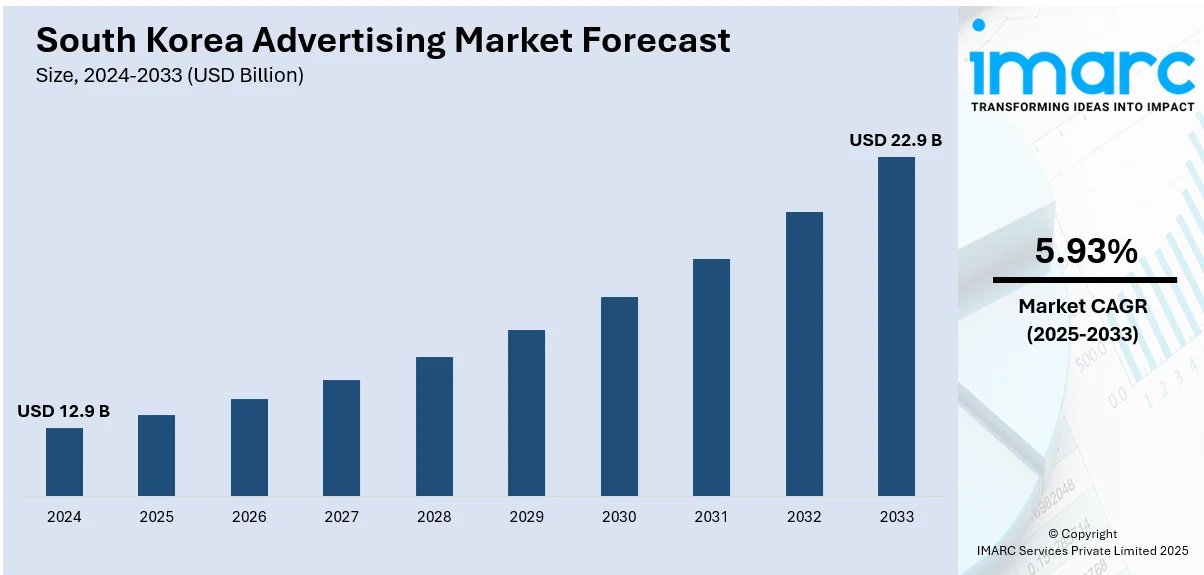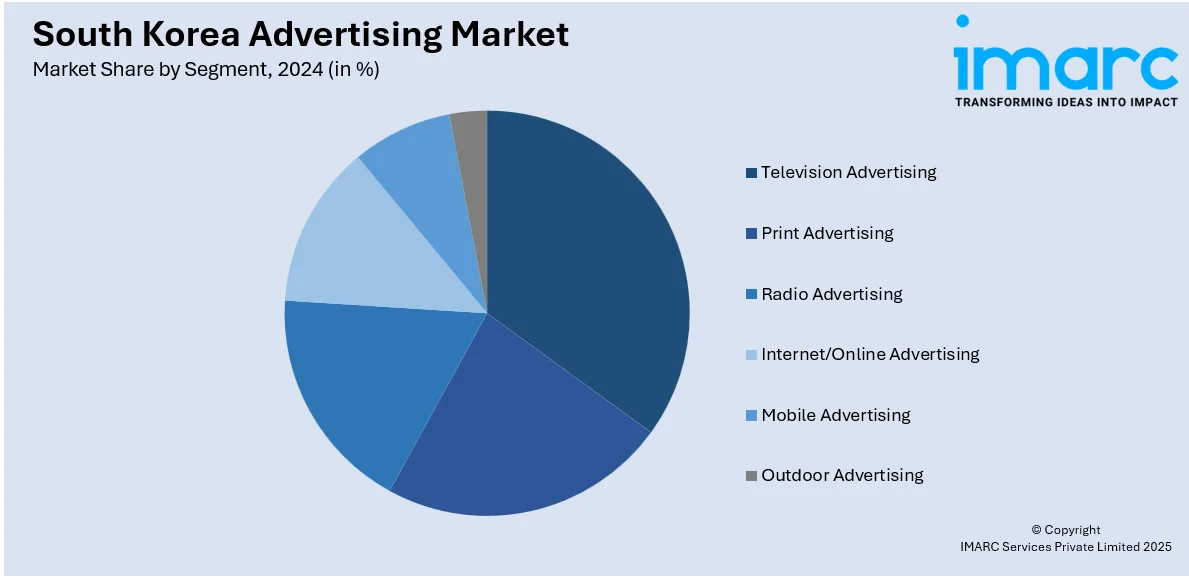
South Korea Advertising Market Size, Share, Trends and Forecast by Segment and Region, 2025-2033
South Korea Advertising Market Overview:
The South Korea advertising market size reached USD 12.9 Billion in 2024. The market is projected to reach USD 22.9 Billion by 2033, exhibiting a growth rate (CAGR) of 5.93% during 2025-2033. The market is expanding due to increased adoption of AI-driven content creation and a rising demand for localized digital campaigns. In addition, growing investments in data-backed marketing tools continue to support South Korea Advertising market share across entertainment, finance, and e-commerce sectors.
|
Report Attribute
|
Key Statistics
|
|---|---|
|
Base Year
|
2024
|
|
Forecast Years
|
2025-2033
|
|
Historical Years
|
2019-2024
|
| Market Size in 2024 | USD 12.9 Billion |
| Market Forecast in 2033 | USD 22.9 Billion |
| Market Growth Rate 2025-2033 | 5.93% |
South Korea Advertising Market Trends:
AI-Driven Transformation in Advertising
South Korea’s advertising sector has entered a new era where artificial intelligence plays a central role in reshaping how campaigns are created, monitored, and optimized. Agencies are now investing heavily in proprietary AI tools to reduce manual workloads and increase creative precision. These platforms streamline tasks such as visual generation, compliance auditing, and performance tracking, leading to faster execution and more consistent output across multiple channels. Advertisers benefit from improved productivity and reduced time-to-market, enabling them to respond swiftly to consumer behavior and trends. In June 2025, leading firms like Cheil Worldwide and Innocean rolled out custom-built AI systems that automated major parts of the ad-making process, including campaign monitoring, content creation, and brand compliance checks. This shift has not only decreased production costs but also empowered teams to focus on strategic storytelling and high-level ideation. As a result, South Korea has emerged as a frontrunner in AI-led advertising innovation. The rise of intelligent automation tools signals a long-term shift in how creative industries operate, encouraging a move toward data-driven decision-making. The integration of AI continues to redefine agency structures, campaign strategies, and talent deployment, contributing significantly to South Korea advertising market growth across digital and traditional platforms.

To get more information on this market, Request Sample
Localized Content and Market Expansion
As audiences in South Korea demand more contextually relevant content, advertisers are focusing on developing campaigns that resonate with local values, culture, and current affairs. The ability to localize global information in real-time allows marketers to connect more effectively with consumers, particularly in sectors like finance, news, and technology. This has pushed companies to explore platforms that can merge data accuracy with speed, enabling more informed and timely ad placements. Localization also increases trust and brand relevance, which are key in competitive digital environments. In November 2024, Dow Jones launched its first Korean-language AI-powered newswire service in Seoul, aimed specifically at serving the nation’s financial community with real-time global news updates. This expansion allowed advertisers to gain deeper insights into market dynamics, thereby enhancing the targeting and timing of their campaigns. By leveraging AI-driven translation and news delivery, companies are now able to produce content that mirrors current financial trends and consumer sentiment. The result is more agile and responsive marketing strategies tailored to South Korea’s unique media landscape. As international firms follow this lead, the trend toward content localization is expected to grow, opening new doors for audience engagement, market penetration, and creative differentiation within the South Korean advertising space.
South Korea Advertising Market Segmentation:
IMARC Group provides an analysis of the key trends in each segment of the market, along with forecasts at the country and regional level for 2025-2033. Our report has categorized the market based on segment.
Segment Insights:

- Television Advertising
- Print Advertising
- Newspaper
- Magazines
- Radio Advertising
- Internet/Online Advertising
- Mobile Advertising
- Outdoor Advertising
- Bill Boards
- Street Furniture
- Transit Advertising
- Other Mediums
The report has provided a detailed breakup and analysis of the market based on the segment. This includes television advertising, print advertising (newspaper and magazines), radio advertising, internet/online advertising, mobile advertising, and outdoor advertising (bill boards, street furniture, transit advertising, and other mediums).
Regional Insights:
- Seoul Capital Area
- Yeongnam (Southeastern Region)
- Honam (Southwestern Region)
- Hoseo (Central Region)
- Others
The report has also provided a comprehensive analysis of all the major regional markets, which include Seoul Capital Area, Yeongnam (Southeastern Region), Honam (Southwestern Region), Hoseo (Central Region), and others.
Competitive Landscape:
The market research report has also provided a comprehensive analysis of the competitive landscape. Competitive analysis such as market structure, key player positioning, top winning strategies, competitive dashboard, and company evaluation quadrant has been covered in the report. Also, detailed profiles of all major companies have been provided.
South Korea Advertising Market News:
- July 2025: KT&G and PMI Korea intensified competition in South Korea’s heated tobacco market through aggressive advertising. KT&G launched a half-price device promotion, while PMI Korea expanded youth-focused experiential marketing at the Waterbomb Festival, boosting brand engagement and reshaping advertising strategies in the tobacco sector.
- June 2025: Coupang Play launched South Korea’s first free ad-supported streaming service, offering content access in exchange for pre-roll and mid-roll ads. This move expanded advertising opportunities in digital media, signaling a major shift in South Korea’s streaming and advertising market dynamics.
South Korea Advertising Market Report Coverage:
| Report Features | Details |
|---|---|
| Base Year of the Analysis | 2024 |
| Historical Period | 2019-2024 |
| Forecast Period | 2025-2033 |
| Units | Billion USD |
| Scope of the Report |
Exploration of Historical Trends and Market Outlook, Industry Catalysts and Challenges, Segment-Wise Historical and Future Market Assessment:
|
| Products Covered |
|
| Regions Covered | Seoul Capital Area, Yeongnam (Southeastern Region), Honam (Southwestern Region), Hoseo (Central Region), Others |
| Customization Scope | 10% Free Customization |
| Post-Sale Analyst Support | 10-12 Weeks |
| Delivery Format | PDF and Excel through Email (We can also provide the editable version of the report in PPT/Word format on special request) |
Key Questions Answered in This Report:
- How has the South Korea advertising market performed so far and how will it perform in the coming years?
- What is the breakup of the South Korea advertising market on the basis of segment?
- What is the breakup of the South Korea advertising market on the basis of region?
- What are the various stages in the value chain of the South Korea advertising market?
- What are the key driving factors and challenges in the South Korea advertising market?
- What is the structure of the South Korea advertising market and who are the key players?
- What is the degree of competition in the South Korea advertising market?
Key Benefits for Stakeholders:
- IMARC’s industry report offers a comprehensive quantitative analysis of various market segments, historical and current market trends, market forecasts, and dynamics of the South Korea advertising market from 2019-2033.
- The research report provides the latest information on the market drivers, challenges, and opportunities in the South Korea advertising market.
- Porter's Five Forces analysis assists stakeholders in assessing the impact of new entrants, competitive rivalry, supplier power, buyer power, and the threat of substitution. It helps stakeholders to analyze the level of competition within the South Korea advertising industry and its attractiveness.
- Competitive landscape allows stakeholders to understand their competitive environment and provides an insight into the current positions of key players in the market.
Need more help?
- Speak to our experienced analysts for insights on the current market scenarios.
- Include additional segments and countries to customize the report as per your requirement.
- Gain an unparalleled competitive advantage in your domain by understanding how to utilize the report and positively impacting your operations and revenue.
- For further assistance, please connect with our analysts.
 Request Customization
Request Customization
 Speak to an Analyst
Speak to an Analyst
 Request Brochure
Request Brochure
 Inquire Before Buying
Inquire Before Buying




.webp)




.webp)












